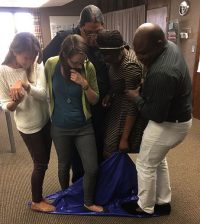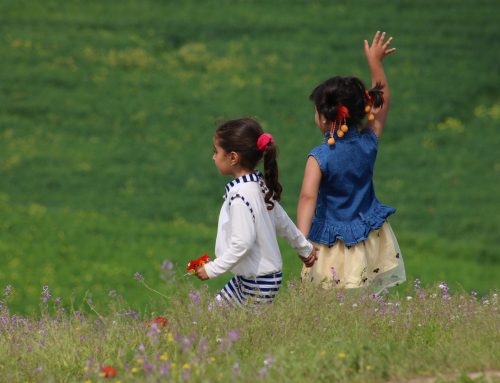Above, Erin Gager (in green sweater) participates in JVA’s Evaluation Intensive training in 2017.
Erin Gager, Joining Vision and Action’s new evaluation and engagement manager, began her career in the early childhood field and recently completed her master’s in research and evaluation methods at the University of Colorado Denver. We asked her to share a bit about her past work, what motivates her, and what she’s hoping to do at JVA. We’re excited to have her on the team!
What led you to apply to JVA?

Erin Gager has skills in project management, integrating qualitative and quantitative data, and survey design.
I had heard of JVA for years. I actually took the Evaluation Intensive and a handful of other trainings with JVA earlier in my career. I also had worked with the wonderful Stella Carrasco to reserve JVA’s training space for early childhood educator trainings back when I managed those professional development offerings.
I have also been an avid follower of JVA’s 411 newsletter, and seen some of the great work they have done for nonprofit organizations, including some in the early childhood field.
So when I saw the opportunity come up to use my evaluation skills and passion at such a great organization, I jumped at the chance to apply!
What excites you the most about your new position? What is your favorite thing about this type of work?
Having worked extensively on the program implementation side of nonprofits, I know first-hand how evaluation can feel—intimidating, like an “extra” work task, an excuse to “judge” your work. But I have also seen the power of evaluation when it is done well, meaning it is a collaborative effort that is incorporated into the day-to-day work that allows for increased learning and demonstration of impact.
So I am excited about the opportunity to bring this perspective and skills to a wide variety of nonprofits and support them to be successful in their evaluation efforts. I am also excited to work with a wide range of nonprofits across the country and across different industries. I think there are lessons we can learn from each other, and grow our nonprofit best practices together.
Much of your professional experience has been in the early childhood field. Do you feel like your work in this field taught you any particular lessons that are more broadly applicable—to your work or to life in general?

Erin Gager (second from left) participates in the Flip the Tarp activity during a JVA training.
I think working in the early childhood field helped to solidify for me that we are really all just big ol’ kids!
A lot of the best practices for children don’t become irrelevant as we reach adulthood. We all need reliable, trusting relationships in life and at work in order to perform as our best selves. We can all benefit from scaffolded learning and positive reinforcement, from the chance to experiment and see what works, from the chance to be creative and play.
We all need an environment where we can feel safe enough to be adventurous. That is the kind of environment I look for anywhere I work, and that I hope to help cultivate myself—for my JVA team and our clients.
Tell us about one of your favorite projects or an accomplishment you are especially proud of.
One accomplishment I didn’t mention in my bio so far is related to my work with supporting the early childhood workforce.
I started managing the professional development department at Denver’s Early Childhood Council only a few years into my career, and it quickly became a passion where I would spend any free moment at work reading about the research and best practices around how to support this amazing group of teachers, assistant teachers, directors and others who make early childhood experiences supportive for children and families.
During my time in this department, we expanded our offerings from offering trainings to also include career navigation/advising, hosting an appreciation awards event, hosting a career fair, and writing grants to continue expanding our efforts. I love projects where we can imagine and try out solutions that are “out of the box” and driven by strong relationships with our partners and community.
You mention in your bio that you create textile art, including crocheting, sewing, visible mending, macrame and embroidery. How did you become interested in this, and what do you enjoy about it?
I actually got into textile art first through crocheting, which I learned the basics of from my first deskmate (and still treasured friend) at the Denver Early Childhood Council. From there, I continued to learn and play with new mediums periodically—I think I want to dive deep into tie dye techniques next.
I appreciate that it is a way to use creative expression with a variety of tools and materials. I also like that you can create wearable, practical items that are also unique or one-of-a-kind. I like to think there is also something subtly subversive about thinking about textile as art, and trying to redefine the traditional divide between “fine art” and “crafts,” which speaks to both gender and racial divides around whose creations “count” as art.
As Erin notes, evaluation can help your organization increase its learning and demonstrate its impact. Read more about JVA’s evaluation and engagement services, or reach out to us for more information!







Leave A Comment